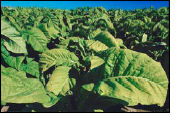Pocket K No. 26: Molecular Pharming and Biopharmaceuticals
| |
What are Biopharmaceuticals?
 With the advent of genetic engineering, scientists are able to engineer living organisms, from the simple yeasts to the more complex plants, to produce specific pharmaceuticals. Biopharmaceuticals are drug products (proteins, including antibodies) produced in living systems and used for therapeutic or diagnostic purposes or as dietary supplements.
With the advent of genetic engineering, scientists are able to engineer living organisms, from the simple yeasts to the more complex plants, to produce specific pharmaceuticals. Biopharmaceuticals are drug products (proteins, including antibodies) produced in living systems and used for therapeutic or diagnostic purposes or as dietary supplements.
The use of plants to express proteins can be more practical, safe and economical compared to other biological systems. Plant systems allow production with low start-up costs because the expensive equipment used in microbial systems are not required. The production of these compounds in plants is sometimes called molecular pharming.
The first full size native protein expressed in plants was human serum albumin, produced in 1990 in transgenic tobacco and potato plants. Years after this pioneering work, two plant-derived pharmaceuticals (PDPs) or plant-made pharmaceuticals (PMPs) have been commercialized (one in Cuba and one in the US). Europe is expected to commercialize PDPs in 20091,2. A wide array of PDPs are now in the pipeline for commercialization to treat diseases such as cystic fibrosis and non-Hodgkin’s lymphoma, among others (see Table 1). There are also various veterinary applications of plant-derived vaccines and therapeutic proteins but these will not be discussed
here.
| Table 1: Plant-derived pharmaceuticals for the treatment of human diseases that are in the pipeline for commercialization. | |||
| Product | Class | Indication | Crop |
| Various single-chain Fv antibody fragments | Antibody | Non-Hodgkin’s lymphoma | Viral vectors in tobacco |
| CaroRx | Antibody | Dental caries | Transgenic tobacco |
| E. coli heat-labile toxin | Vaccine | Diarrhea | Transgenic maize Transgenic potato |
| Gastric lipase | Therapeutic enzyme | Cystic fibrosis, pancreatitis | Transgenic maize |
| Hepatitis B virus surface antigen | Vaccine | Hepatitis B | Transgenic potato Transgenic lettuce |
| Human intrinsic factor | Dietary | Vitamin B12 deficiency | Transgenic Arabidopsis |
| Lactoferrin | Dietary | Gastrointestinal infection | Transgenic maize |
| Norwalk virus capsid protein | Vaccine | Norwalk virus infection | Transgenic potato |
| Rabies glycoprotein | Vaccine | Rabies | Viral vectors in spinach |
| Cyanoverin-N | Microbicide | HIV | Transgenic tobacco |
| Insulin | Hormone | Diabetes | Transgenic safflower |
| Lysozyme, Lactoferrin, Human serum albumin | Dietary | Diarrhea | Transgenic rice |
| Sources: Compiled by ISAAA, 2007. | |||
What Plants are Used for Biopharma Production?
 Transgenic tobacco is by far the most popular choice in many studies on plant-produced proteins because of its high biomass yields and rapid scalability. In addition, it is not used as food or feed, and so carries a reduced risk of transgenic material contaminating food and feed supplies1. Transgenic tobacco has recently been used in Cuba for the commercial production of a recombinant antibody against hepatitis B2.
Transgenic tobacco is by far the most popular choice in many studies on plant-produced proteins because of its high biomass yields and rapid scalability. In addition, it is not used as food or feed, and so carries a reduced risk of transgenic material contaminating food and feed supplies1. Transgenic tobacco has recently been used in Cuba for the commercial production of a recombinant antibody against hepatitis B2.
Aside from tobacco, other leafy crops such as lettuce and alfalfa have been studied for biopharmaceutical production. Harvested material from leafy crops must be processed immediately due to the rapid degeneration of proteins in leaves. To circumvent the problem of short shelf life, cereal grains like rice, wheat, barley, and maize are also being developed to produce the PDPs1. Maize, for example, has already been used for the commercial production of recombinant avidin, b-glucuronidase and trypsin by ProdiGene Inc. in the United States2.
 Potato was the first system to be developed for vaccine production, followed by tomatoes, bananas, carrots, lettuce, maize, alfalfa, spinach, white clover and Arabidopsis as alternative production hosts.
Potato was the first system to be developed for vaccine production, followed by tomatoes, bananas, carrots, lettuce, maize, alfalfa, spinach, white clover and Arabidopsis as alternative production hosts.
Finally, there has been significant progress in the use of plant species which can easily be handled in the laboratory and in the production plant. Simple plants include Chlamydomonas reinhardtii, Lemna (duckweed), and the moss Physcomitrella patens1.
How would Biopharma Benefit Developing Countries?
Agriculture is the lifeblood of many developing countries. Agricultural economies would benefit from a plant-based pharmaceutical platform to improve healthcare. PDPs offer a cost-effective method of production of molecules that could help control infectious diseases prevalent in developing countries, such as malaria and HIV/AIDS3. Tobacco has already successfully been used to produce an anti-HIV cream, currently under laboratory trials in the UK4, while a Belgian pharmaceutical company, Dafra Pharma, has commissioned the Plant Research International (PRI) to begin research in optimizing the production method of anti-malaria artemisinin via transgenic chicory plants5.
 With plants, production of biopharmaceuticals can be tailored to suit local or regional production. Primary extraction facilities could be built in developing countries so that they could derive maximum benefits from the technology. Bringing the technology closer to the target population would draw out greater involvement from these countries, and shift the focus in current drug production to specific regional diseases6. This would also alleviate some of the problems and obstacles associated with the delivery and storage of conventional vaccines and medicines to remote areas with limited infrastructure.
With plants, production of biopharmaceuticals can be tailored to suit local or regional production. Primary extraction facilities could be built in developing countries so that they could derive maximum benefits from the technology. Bringing the technology closer to the target population would draw out greater involvement from these countries, and shift the focus in current drug production to specific regional diseases6. This would also alleviate some of the problems and obstacles associated with the delivery and storage of conventional vaccines and medicines to remote areas with limited infrastructure.
Demand for specific pharmaceuticals is very high especially in developing countries. Recombinant hepatitis B vaccine from genetically-modified yeast, for instance, can not be made in sufficient quantities and at a low enough cost to meet the current demands. The possibility of large-scale production in transgenic plants could offer one of the few practical solutions to overcome these dilemmas. The use of PDPs would undoubtedly assist vaccination programs in developing countries by reducing the costs of vaccine production, purification, storage and administration6.
What are the Risks, Concerns and Issues of PDPs?
The production of plant-derived pharmaceuticals introduces several unique challenges for biosafety regulation and risk-management. Most of these arise from the fact that the plants are generally grown in the open environment. An important environmental concern is therefore the potential gene flow to weeds or related crops through pollination or seed contamination. In addition, and especially in the case where food crops are used for the production of drugs, there are issues about PDPs accidentally entering the food chain and being consumed by non-target organisms.
It is impossible to keep the environmental risks associated with PDPs at absolute zero7. A simple approach would be to grow the transgenic plants producing PDPs in physical isolation. However, a more realistic approach would be to minimize the environmental exposure of these proteins through a combination of precautionary measures. These could comprise the use of genetic use restriction technologies or GURTs, which prevent the unintended escape of the crop to the environment by engineering plants that produce non-viable seeds8. Other strategies include the induction of biopharmaceutical production in the plants after harvesting, and the expression of the proteins in a form that must be treated for activation9. This means that the protein would be in its inactive form in the plant, and only after further modifications or processing the protein would acquire pharmaceutical properties.
A major concern for many developing countries is the lack of biosafety legislation for genetically modified plants. Without a biosafety framework in place, developing countries cannot perform trials of PDPs. In addition, a major challenge is the high cost of development and of regulatory compliance. Although large scale production of PDP may be more economical, the intial stages of development and biosafety tests may be prohibitively costly. Regulatory requirements for drug development and manufacture, the high failure rate of new drugs, and the protection of intellectual property also contribute to the price of new vaccines1.
The adoption of PDPs may also raise ethical and religious issues. Among the ethical objections to GM plants, and to genetic engineering in general, are concerns that altering living organisms is like ‘playing God’10.
Conclusion
 The production of plant-derived pharmaceuticals may provide a cheaper and better alternative source of medicines for both developed and developing countries. The latter will stand to benefit the most from PDPs because of reduced costs of drug production, the possibility of large scale production, and the complementarity of the technology with agriculture. Locally grown crops can be developed for PDPs, which could make them more practical and economical for use in developing countries. However, there are risks, concerns, and other issues which need to be addressed before this technology can be commercially released around the world.
The production of plant-derived pharmaceuticals may provide a cheaper and better alternative source of medicines for both developed and developing countries. The latter will stand to benefit the most from PDPs because of reduced costs of drug production, the possibility of large scale production, and the complementarity of the technology with agriculture. Locally grown crops can be developed for PDPs, which could make them more practical and economical for use in developing countries. However, there are risks, concerns, and other issues which need to be addressed before this technology can be commercially released around the world.
| |
References:
- Fischer, R., Stoger, E., Schillberg, S., Christou, P. and R. M. Twyman. 2004. Current Opinion in Plant Biology. 7:152-158.
- Sparrow, P., Irwin, J.A., Dale, P.J., Twyman, R.M. and J.K. Ma. 2007. Transgenic Research. 16:147-161.
- Ma, J. K., Chikwamba, R., Sparrow, P., Fischer, R., Mahoney, R. and R. M. Twyman. 2005. Trends in Plant Science. 10:581-585.
- Sexton, A., Drake, P.M., Mahmood, N., Harman, S.J., Shattock, R.J., and J. K. Ma. 2005. FASEB Journal. http://www.fasebj.org/cgi/doi/10.1096/fj.05-4742fje.
- http://sev.prnewswire.com/biotechnology/20070508/3406093en-1.html.
- EMBO. 2005. EMBO Reports. 6:593-599.
- Ledford, H. 2007. Nature. 445:132-133.
- ISAAA-Global Knowledge Center on Crop Biotechnology. 2006. Pocket K No. 21: Gene Switching and GURTs: What, How and Why?
- Daniell, H., Streatfield, S. J. and K. Wycoff. 2001. Trends in Plant Science. 6:219-226.
- Robert, J.S. and D.D. Kirk. 2006. The American Journal of Bioethics. 6:W29-W41.
